译文分享|非特异性颈部疼痛的康复训练研究现状综述
高水平运动员和周末疯狂训练的人都会受到颈部疼痛的影响。在大多数情况下,这种运动型颈部疼痛是轻微损伤的结果,如韧带扭伤,肌肉拉伤或软组织挫伤。运动员良性颈部疼痛的流行数据缺乏,可能是由于这一人群的调查统计工作主要集中在严重的颈椎损伤(如骨折),例如自行车运动员颈部疼痛的发生率相对较高,但运动员颈部疼痛的报道往往缺乏骑行者。无论症状起因如何,颈部疼痛的运动员可能在肌肉募集能力,力量和耐力,重新定位能力,姿态稳定性,以及动眼控制方面出现缺陷。颈部疼痛运动员也可能有运动障碍。在越来越多的证据支持康复训练的价值,以解决与颈部疼痛相关的不足。因为针对运动员颈部问题相关的随机对照试验数据比较缺乏,因此,以下讨论的康复训练是普适性的颈部伤痛,并不是特别针对运动损伤。不过,临床医生和物理治疗师在制定康复训练计划之前应该考虑运动项目的特殊性。
通过训练改善灵活性研究表明,至少在短期内自我伸展运动可以减少颈部疼痛。Ylinen等调查发现,每周拉伸5次对于减少慢性颈部疼痛与手法治疗相比同样有效。 对于斜角肌,上斜方肌,肩胛提肌,小胸大肌和胸大肌的伸展运动可能是有帮助的。使用泡沫滚轮进行胸廓伸展自我运动有对于胸椎后凸角度增加导致颈部疼痛的运动员很有帮助(图1)。
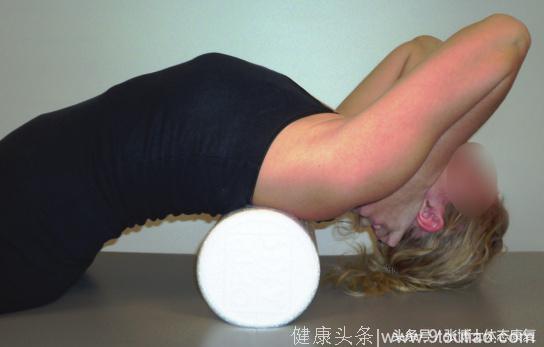
图1:泡沫轴伸展胸椎
另外胸小肌伸展也可能减少胸椎后凸,使用外展90°角的自我伸展方法(图2)可有效延长胸小肌。
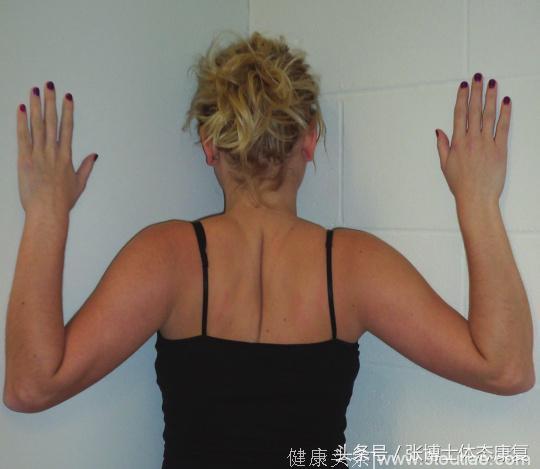
图2:伸展胸小肌
借助部分充气的健身球主动或辅助头部旋转有益于缺乏颈椎旋转活动度的运动员(图3),当患者主动转动时,可以用半英寸至1英寸宽的尼龙或棉质表带在颈部的对侧关节突上施加指向前方的力。
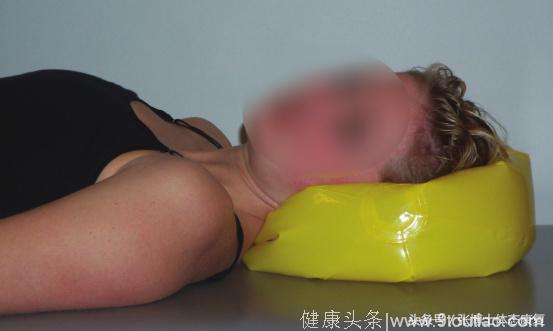
图3:健身球辅助头部旋转
用带子,枕套或毛巾在颈段以下创建支点(图4a), 或者,食指和/或中指可以形成动态调节支点,从而将伸展运动“定位”到受限运动节段(图4b)。
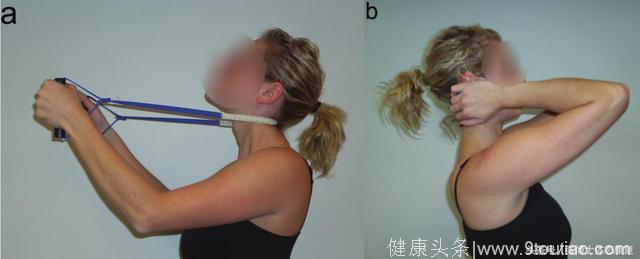
图4:定位伸展颈椎
神经滑动练习对于一些有颈部疼痛伴有神经根性手臂症状的运动员可能是有益的。McKenzie主张往复运动(如颈部缩回)促进远-近端症状迁移或“趋向集中”。单独颈部疼痛的运动员可以通过颈椎回缩训练(图5)来减少颈部下段在前方承受的剪切力,增加颈椎前上方屈曲,激活颈部深层屈肌和伸肌。这个练习可能对有头部前移姿势的运动员(例如骑自行车的人)特别有益。
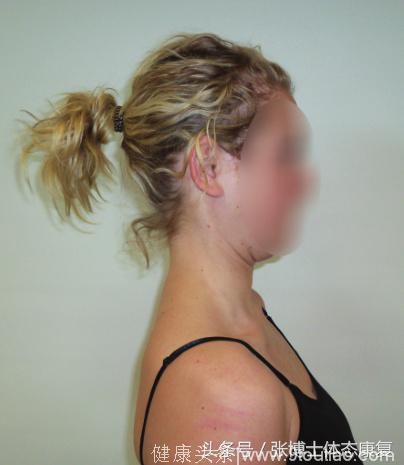
图5:颈椎回缩训练
通过运动改善颈部深层肌肉的募集能力颈部肌肉募集能力降低可能在颈部疼痛发作后迅速发展,并且会在症状消失的情况下持续存在。由于颈部肌肉组织提供了大约80%的颈椎机械稳定性,因此肌肉损伤的后果可能十分严重。在颈部疼痛时,可能会发生颈部深层屈肌(图6)和伸肌失活、募集能力缺失,应该进行标准化的检查以确定是否存在问题。
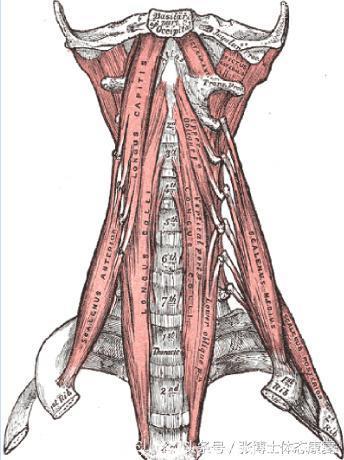
图6:颈部深层屈肌
针对需要进行颈部深层屈肌测试和训练的运动员,可以使用气压计进行(图7),这个练习需要慢慢的屈曲颈椎以减少颈椎曲度,尽最大程度收缩颈部深层的屈肌,同时尽量减少浅层屈肌(胸锁乳突肌,前斜角肌等)的激活,收缩力量不需要太大,重点应放在精确的运动控制上。
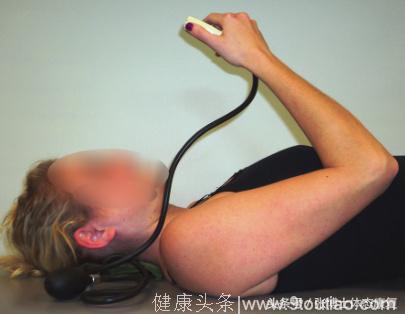
图7:使用气压计训练颈部深层屈肌
如上图所示(图7), 患者仰卧, 将气压计充气至20mmHg并放置在上颈椎(枕骨下)和桌子之间。 从中立的脊柱位置开始,病人缓慢而细微的向前弯曲颅颈段颈椎,如果患者说“可以”,同时保持胸锁乳突肌(SCM)的肌肉放松。让颈椎屈曲生理曲度变平,同时压力增高。 临床医生应该监测不必要的SCM激活。 如果发现募集到了颈阔肌或舌骨肌,可以让患者将舌头顶住下颚,嘴唇并在一起,但牙齿稍微分开,以减少这些肌肉的激活。 一旦患者能够控制和改变装置中的压力,则应该练习保持增加的压力水平,直到他能够以最少的SCM激活保持30mmHg的压力10秒。
以上的运动应该是非常轻微和精准的,这样的运动控制和精确度训练也可以改善颈部重新定位的精确度。为了改善深部和浅部屈肌之间的协同作用,可以在直立位练习(图8a)以使重力的影响最小化,可以通过倾斜身体增加阻力。一旦患者通过练习可以在仰卧位进行颈椎上段屈曲(即点头),并使颈部浅层屈肌的激活最小化,那么他就应该能够完成颈椎向前弯曲的测试(图8b)。如果无法维持向前弯曲姿态的结果是下颌前伸、头部上抬(图8c),这表明训练应该退回到能够标准完成动作的阶段。

图8 颈椎屈曲测试与训练
颈椎下段伸展同时上段(颅颈交界处)保持屈曲的中立位是非常好的颈椎深层屈肌的训练(图9)。采用四点跪撑姿态,用肘关节支撑身体,患者离心收缩后侧伸肌让颈椎下段向前弯曲,同时保持中立的颅颈位置(即头部和上颈椎段不弯曲和伸展),然后缓慢向后伸展下颈椎段,回到起始位置。
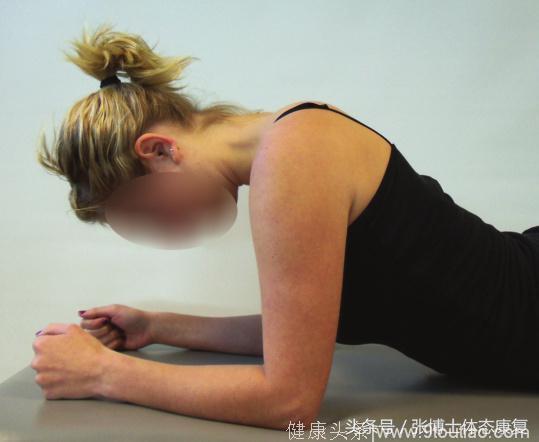
图9:跪撑颈椎中立位训练
在仰卧位的颈椎深层屈肌训练,如图10所示,患者头枕软毛巾,缓慢的收下颌将枕骨下压,而不要弯曲颈椎。
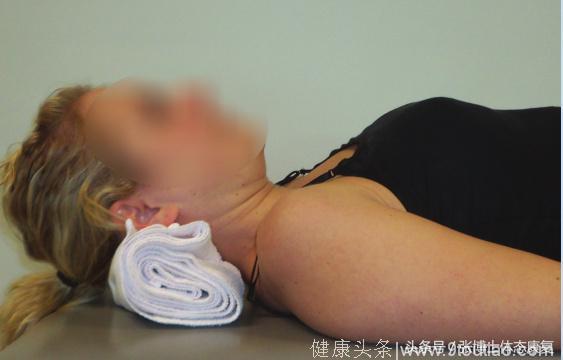
图10、仰卧颈椎深层屈肌练习
采用坐位或站立位, 患者屈曲肘关节将弹力带绕过颈椎(图a),然后缓慢地伸出肘部以向颈部伸肌提供渐进的等长阻力(图b), 在运动过程中患者应该保持头颈排列位于中立位。
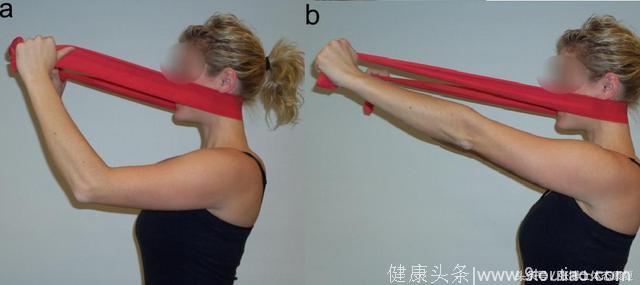
图11、弹力带颈椎伸肌等长收缩训练
肌肉耐力或力量训练一旦颈部深层肌肉的募集能力得到改善,就应该开始进行肌肉耐力和力量训练。 耐力和力量训练都可以减少颈部疼痛。对于耐力型运动员(如自行车)采用中低强度的肌肉耐力训练是合理的。 对于稳定性和力量需求较高的运动员(例如摔跤运动员,足球运动员),应考虑使用大负荷的抗阻力训练方法。
颈部疼痛在女性中更为常见,这可能是由于女性肌肉力量较弱的原因。健康女性与男性相比,颈部屈、伸肌力量分别减少了大约30%和20%。因此,在运动过程中女性颈部肌肉的稳定能力较差,所以对于颈部疼痛的女性运动员来说,力量训练尤其有效。除了颈部固有的肌肉组织外,肩胛部位的肌肉(肩胛提肌,斜方肌)也会对颈椎和肩带产生影响。薄弱的肩胛部位肌肉、特别是斜方肌,在颈部疼痛的患者身上很常见。因此,加强斜方肌力量对改善颈部疼痛可能是有益的(表1)。
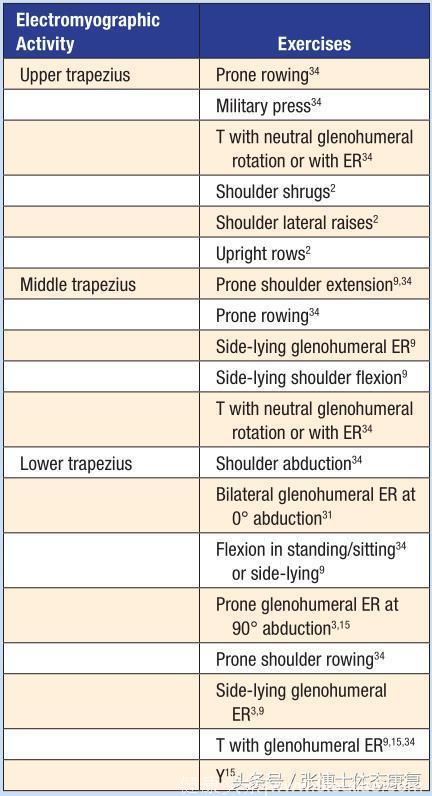
表1:常见的斜方肌训练方法
大部分力量增长都是在第一组的训练刺激下发生的。因此,美国运动医学学会建议每个训练做1组,每组至力竭。 Pollock等研究表明,健康受试者进行1或2组,重复8-12次的颈椎伸肌训练,力量增加并没有统计学差异。根据Randlov等人的研究,颈部疼痛的患者在3个月内进行1组或5组颈肩肌肉训练 ,在疼痛感受、日常活动、肌肉力量和耐力的增长等方面结果并没有差异。
通过训练改善定位准确性、动眼控制和姿态稳定性患有慢性或复发性颈部疾病的人容易出现颅颈定位准确性、姿势稳定性和动眼控制能力下降, 这显然是由颈椎机械感受器信息输入功能受损引起的。虽然颈椎下段传入信息受损造成的感觉运动功能障碍与非创伤性疼痛引起的功能障碍不同,但不管来源如何,通过训练都可以纠正一些感觉运动功能障碍。
定位精准性可以使用光源和目标体进行训练(图12),当患者睁眼时,临床医生被动移动患者的头颈部,直到目光瞄准指定的焦点,然后让患者闭眼,临床医生被动地将患者的头颈部向多个方向移动,使他们感到迷惑。 此后,在眼睛仍然关闭的情况下,患者主动重新定位头颈部以尝试将光源瞄准指定的起始焦点。 在保持这个位置的同时,病人睁眼来评估重新定位的准确性。 定位练习应以稳定的坐姿或站姿开始,并逐渐进阶加入不稳定的表面(如瑞士球,平衡板等)。
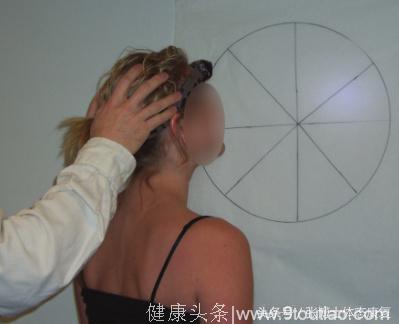
动眼控制训练以改善眼睛/头部协同功能和注视稳定性, 通过将视觉固定在目标上训练,可以从头部固定练习进阶到躯干或头部运动。另外可以增加眼睛,头部或躯干运动的速度和幅度,改变背景和视觉目标以增加挑战。改善动眼控制的练习方法(表2)可以减少运动员颈部出现问题时的头晕和疼痛,改善姿态控制和颈椎运动范围。
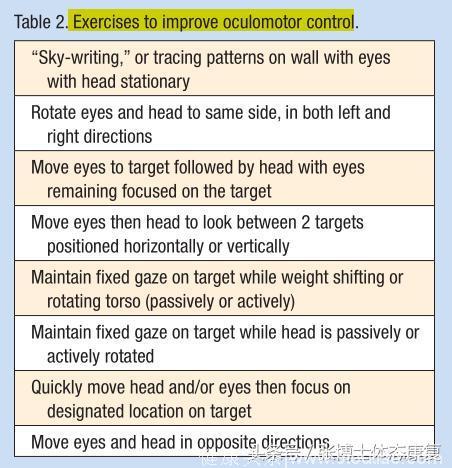
表2:动眼控制训练
姿态稳定性练习通常从稳定表面向不稳定表面进阶,从双侧练习过渡到单侧(表3)。这些练习应该具备一定的运动专项性,并包括改变速度,方向和重心。 适当的时候,在运动员回归比赛之前,应将上肢和/或下肢大强度的训练如敏捷性和超等长练习逐渐加入训练计划中。
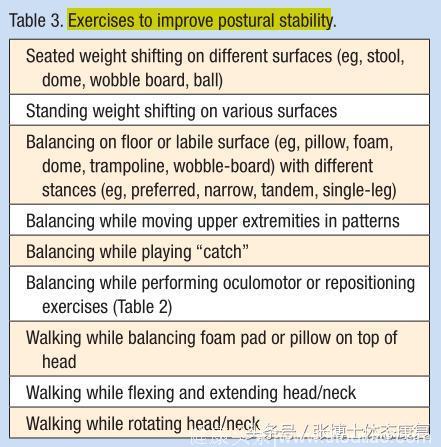
表3:改善姿态稳定性的练习
发展躯干/核心力量,增加颈部肌肉耐力的练习应该加入计划,如在治疗球上支撑头部和肩部的仰卧位锻炼可以为颈肌肉提供更高水平的等长挑战(图13)。当运动员没有明显症状,颈椎恢复运动范围并具体肌肉力量时,才可以进行不受限制的运动。
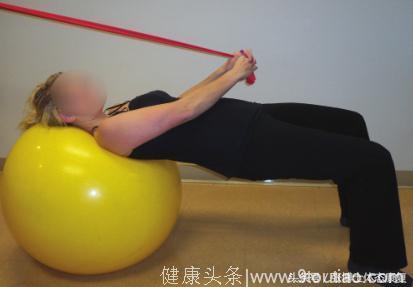
图13:瑞士球上对角线拉弹力带
总结:颈部疼痛的运动员可能在运动能力,肌肉力量,力量和耐力,定位精准性,姿态稳定性,或动眼控制方面有缺陷。 针对颈部疼痛的康复训练计划应该解决以上问题, 让运动员为重返赛场做好准备。
翻译:田德
审译:张魏磊
参考文献1. American College of Sports Medicine. Position stand on progression models in resistance training for healthy adults. Med Sci Sports Exerc. 2002;34(2):364-380.
2. Andersen LL, Kjaer M, Andersen CH, et al. Muscle activation during selected strength exercises in women with chronic neck muscle pain. Phys Ther. 2008;88(6):703-711.
3. Ballantyne BT, O’Hare S, Paschall J, et al. Electromyographic activity of selected shoulder muscles in commonly used therapeutic exercises. Phys Ther. 1993;73:668-682.
4. Behrsin J, Maguire K. Levator scapulae action during shoulder movement: a possible mechanism for shoulder pain of cervical origin. Aust J Physiother. 1986;32:101-106.
5. Borstad JD, Ludewig PM. Comparison of three stretches for the pectoralis minor muscle. J Shoulder Elbow Surg. 2006;15:324-330.
6. Cagnie B, O’Leary S, Elliott J, Peeters I, Parlevliet T, Danneels L. Pain-induced changes in the activity of the cervical extensor muscles evaluated by muscle functional magnetic resonance imaging. Clin J Pain. 2011;27(5):392-397.
7. Childs JD, Cleland JA, Elliott JM, et al. Neck pain: clinical practice guidelines linked to the International Classification of Functioning, Disability, and Health from the Orthopedic Section of the American Physical Therapy Association. J Orthop Sports Phys Ther. 2008;38:A1-A34.
8. Chui TTW, Law EYH, Chui THF. Performance of the craniocervical flexion test in subjects with and without chronic neck pain. J Orthop Sports Phys Ther. 2005;35(9):567-571.
9. Cools A, Dewitte V, Lanszweert F, et al. Rehabilitation of scapular muscle balance: which exercises to prescribe? Am J Sports Med. 2007;35:1744-1750.
10. Coppieters MW, Hough AD, Dilley A. Different nerve-gliding exercises induce different magnitudes of median nerve longitudinal excursion: an in vivo study using dynamic ultrasound imaging. J Orthop Sports Phys Ther. 2009;39:164-171.
11. De Jong PI, DeJong JM, Cohen B, Jongkees LB. Ataxia and nystagmus induced by injection of local anaesthetics in the neck. Ann Neurol. 1977;1:240-246.
12. de Koning CH, van den Heuvel SP, Staal JB, Smits-Engelsman BC, Hendriks EJ. Clinimetric evaluation of methods to measure muscle functioning in patients with non-specific neck pain: a systematic review. BMC Musculoskelet Disord. 2008;9:142.
13. Dorshimer GW, Kelly M. Cervical pain in the athlete: common conditions and treatment. Prim Care. 2005;32(1):231-243.
14. Durall C, Hermsen D, Demuth C. Systematic review of single-set versus multiple-set resistance-training randomized controlled trials: implications for rehabilitation. Crit Rev Phys Rehab Med. 2006;18(2):107-116.
15. Ekstrom RA, Donatelli RA, Soderberg GL. Surface electromyographic analysis of exercises for the trapezius and serratus anterior muscles. J Orthop Sports Phys Ther. 2003;33:247-258.
16. Elliott JM, O’Leary SP, Cagnie B, Durbridge G, Danneels L, Jull G. Craniocervical orientation affects muscle activation when exercising the cervical extensors in healthy subjects. Arch Phys Med Rehabil. 2010;91(9):1418-1422.
17. Falla D, Bilenkij G, Jull G. Patients with chronic neck pain demonstrate altered patterns of muscle activation during performance of a functional upper limb task. Spine. 2004;29:1436-1440.
18. Falla D, Farina D, Dahl MK, Graven-Nielsen T. Muscle pain induces task-dependent changes in cervical agonist/antagonist activity. J Appl Physiol.2007;102:601-609.
19. Falla D, Jull G, Dall’Alba P, Rainoldi A, Merletti R. An electromyographic analysis of the deep cervical flexor muscles in performance of craniocervical flexion. Phys Ther. 2003;83:899-906.
20. Falla D, Jull G, Hodges P. Patients with neck pain demonstrate reduced electromyographic activity of the deep cervical flexor muscles during performance of the craniocervical flexion test. Spine. 2004;29:2108-2114.
21. Grimmer KA. Measuring endurance capacity of the cervical short flexor muscle group. Aust J Physiother. 1994;40:251-254.
22. Hagen KB, Bjørndal A, Uhlig T, Kvien TK. A population study of factors associated with general practitioner consultation for non-inflammatory musculoskeletal pain. Ann Rheum Dis. 2000;59:788-793.
23. Haskell W. Health consequences of physical activity: understanding and challenges regarding dose-response. Med Sci Sports Exerc. 1994;26:649-660.
24. Jordan A, Mehlsen J, Bulow PM, et al. Maximal isometric strength of the cervical musculature in 100 healthy volunteers. Spine. 1999;24:1343-1348.
25. Jull G, Falla D, Treleaven J, Hodges P, Vicenzino B. Retraining cervical joint position sense: the effect of two exercise regimes. J Orthop Res. 2007;25:404-412.
26. Jull GA, O’Leary SP, Falla DL. Clinical assessment of the deep cervical flexor muscles: the craniocervical flexion test. J Manipulative Physiol Ther. 2008;31(7):525-533.
27. Kristjansson E, Dall’Alba P, Jull G. A study of five cervicocephalic relocation tests in three different subject groups. Clin Rehabil. 2003;17:768-774.
28. Krout RM, Anderson TP. Role of anterior cervical muscles in production of neck pain. Arch Phys Med Rehabil. 1966;47:603-611.
29. Ljungquist T, Harms-Ringdahl K, Nygren A, et al. Intra- and inter-rater reliability of an 11-test package for assessing dysfunction due to back or neck pain. Physiother Res Int. 1999;4:214-232.
30. Mayoux-Benhamou MA, Revel M, Vallee C, et al. Longus Colli has a postural function on cervical curvature. Surg Radiol Anat. 1994;16:367-371.
31. McCabe RA. Surface electromyographic analysis of the lower trapezius muscle during exercises performed below ninety degrees of shoulder elevation in healthy subjects. N Am J Sports Phys Ther. 2007;2:34-43.
32. McKenzie RA. The Cervical and Thoracic Spine: Mechanical Diagnosis and Therapy. Waikanae, New Zealand: Spinal Publications; 2009.
33. Michaelson P, Michaelson M, Jaric S, et al. Vertical posture and head stability in patients with chronic neck. J Rehabil Med. 2003;35:229-235.
34. Moseley J, Jobe F, Pink M, Perry J, Tibone J. EMG analysis of the scapular muscles during a shoulder rehabilitation program. Am J Sports Med. 1992;20:128-134.
35. Murphy DR, Hurwitz EL, Gregory A, Clary R. A nonsurgical approach to the management of patients with cervical radiculopathy: a prospective observational cohort study. J Manipulative Physiol Ther. 2006;29:279-287.
36. O’Leary S, Falla D, Elliott JM, Jull G. Muscle dysfunction in cervical spine pain: implications for assessment and management. J Orthop Sports Phys Ther. 2009;39(5):324-333.
37. O’Leary S, Falla D, Hodges PW, et al. Specific therapeutic exercise of the neck induces immediate local hypoalgesia. J Pain. 2007;8:832-839.
38. O’Leary S, Jull G, Kim M, Vicenzino B. Craniocervical flexor muscle impairment at maximal, moderate, and low loads is a feature of neck pain. Man Ther. 2007;12:34-39.
39. O’Leary S, Jull G, Kim M, Vicenzino B. Specificity in retraining craniocervical flexor muscle performance. J Orthop Sports Phys Ther. 2007;37(1):3-9.
40. Ordway NR, Seymour RJ, Donelson RG, Hojnowski LS, Edwards WT. Cervical flexion, extension, protrusion, and retraction: a radiographic segmental analysis. Spine. 1999;24(3):240-247.
41. Panjabi MM, Cholewicki J, Nibu K, Grauer J, Babat LB, Dvorak J. Critical load of the human cervical spine: an in vitro experimental study. Clin Biomech (Bristol, Avon). 1998;13:11-17.
42. Pollock ML, Graves JE, Bamman MM, et al. Frequency and volume of resistance training: effect on cervical extension strength. Arch Phys Med Rehabil. 1993;74:1080-1086.
43. Randløv A, Østergaard M, Manniche C, et al. Intensive dynamic training for females with chronic neck/shoulder pain: a randomized controlled trial. Clin Rehabil. 1998;12:200-210.
44. Revel M, Minguel M, Gregory P, et al. Changes in cervicocephalic kinesthesia after a proprioceptive rehabilitation program in patients with neck pain: a randomized controlled study. Arch Phys Med Rehab. 1994;75:895-899.
45. Sarig-Bahat H. Evidence for exercise therapy in mechanical neck disorders. Man Ther. 2003;8(1):10-20.
46. Sjolander P, Michaelson P, Jaric S, Djupsjobacka M. Sensorimotor disturbances in chronic neck pain: range of motion, peak velocity, smoothness of movement, and repositioning acuity. Man Ther. 2008;13:122-131.
47. Sterling M, Jull G, Vicenzino B, et al. Development of motor system dysfunction following whiplash injury. Pain. 2003;103:65-73.
48. Taimela S, Takala EP, Asklof T, Seppala K, Parviainen S. Active treatment of chronic neck pain: a prospective randomized intervention. Spine. 2000;25:1021-1027.
49. Treleaven J, Jull G, Low Choy N. Smooth pursuit neck torsion test in whiplash associated disorders: relationship to self-reports of neck pain and disability, dizziness and anxiety. J Rehabil Med. 2005;37:219-223.
50. Treleaven J, Jull G, Low Choy N. Standing balance in persistent WAD: comparison between subjects with and without dizziness. J Rehabil Med. 2005;37:224-229.
51. Vasavada AN, Danaraj J, Siegmund GP. Head and neck anthropometry, vertebral geometry and neck strength in height-matched men and women. J Biomech. 2008;41(1):114-21.
52. Vasavada AN, Li S, Delp SL. Influence of muscle morphology and moment arms on moment-generating capacity of human neck muscles. Spine 1998;23:412-422.
53. Waling K, Sundelin G, Ahlgren C, Jarvholm B. Perceived pain before and after three exercise programs: a controlled clinical trial of women with work-related trapezius myalgia. Pain. 2000;85:201-207.
54. Wang CH, McClure P, Pratt NE, Nobilini R. Stretching and strengthening exercises: their effect on three-dimensional scapular kinematics. Arch Phys Med Rehabil. 1999;80(8):923-929.
55. Weiss BD. Nontraumatic injuries in amateur long distance bicyclists. Am J Sports Med. 1985;13(3):187-192.
56. Werneke MW, Hart DL, Resnik L, Stratford PW, Reyes A. Centralization: prevalence and effect on treatment outcomes using a standardized operational definition and measurement method. J Orthop Sports Phys Ther. 2008;38(3):116-125.
57. Wilber CA, Halland GJ, Madison RE, Loy SF. An epidemiological analysis of overuse injuries among recreational cyclists. Int J Sports Med. 1995;16(3):201-206.
58. Ylinen JJ, Hakkinen AH, Takala EP, et al. Effects of neck muscle training in women with chronic neck pain: one-year follow-up study. J Strength Cond Res. 2006;20(1):6-13.
59. Ylinen J, Kautiainen H, Wiren K, Hakkinen A. Stretching exercises vs manual therapy in treatment of chronic neck pain: a randomized, controlled cross-over trial. J Rehabil Med. 2007;39:126-132.
60. Zmurko MG, Tannoury TY, Tannoury CA, Anderson DG. Cervical sprains, disc herniations, minor fractures, and other cervical injuries in the athlete. Clin Sports Med. 2003;22(3):513-521.